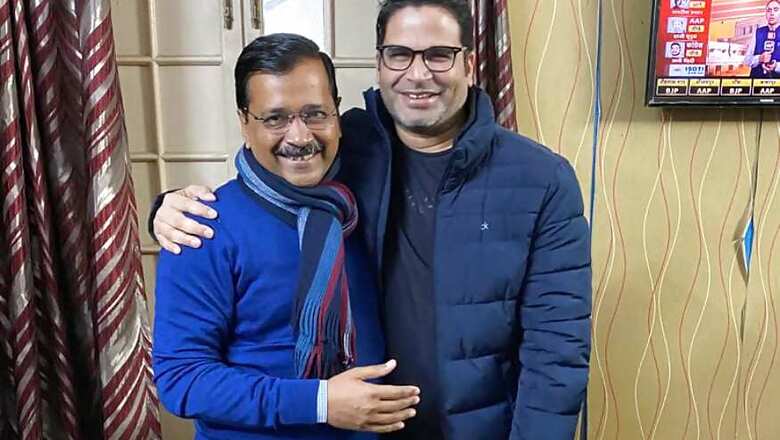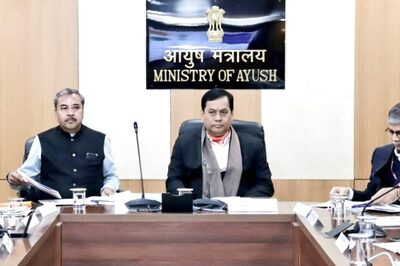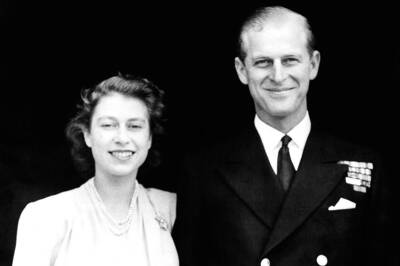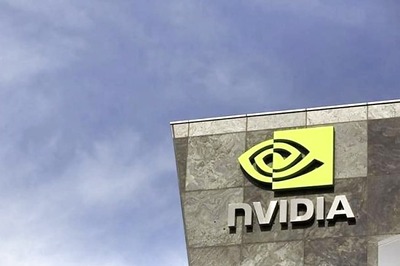
views
The smile on his face was genuine and conspicuous, yet strategic. As he stood on a balcony at the Aam Aadmi Party office in central Delhi, flanked by his wife and jubilant colleagues with scores of supporters cheering on, Arvind Kejriwal thanked, among others, a special someone for the thumping mandate he had received in the assembly election results announced on Tuesday.
“This is the day of Lord Hanuman who has blessed the people of Delhi,” he said, praising the deity who had left an unmistakable imprint on the last lap of the campaign before the February 8 polls. For those who have followed Kejriwal's politics, his faith in Hanuman is no secret. But this repeated reinforcement of his devotion is part of a broad positioning of the AAP chief as being centre-right. Not just Kejriwal; over the past few weeks most candidates from the party were seen at temples, sporting vermilion on their forehead, and organising religious events like jagrata and mata ki chowki.
The bigger game
Tuesday also saw hosts New Zealand complete a 3-0 ODI series whitewash against India: a rare occurrence when the game was eclipsed by another spectacle. There are several similarities between cricket and politics. For instance, momentum is crucial in both. It doesn’t matter if you are world champions in the one-day format; in case you are going into an ODI World Cup with successive losses in Twenty20 and Tests, you often begin to doubt your abilities.
New Zealand were blanked in the preceding T20 series by India. AAP was heading into the Delhi elections following losses in municipal polls, by-elections, as well as a wipeout in the 2019 Lok Sabha polls held eight months ago. Yet, both managed to turn things around. AAP needed a bit of electoral wizardry. Enter poll strategist Prashant Kishor. While, officially, his organisation Indian Political Action Committee (I-PAC) started working with AAP in December 2019, the prelude to this dates back to the month of June.
Two heads together
Soon after the Lok Sabha verdict, in which AAP lost all seven seats in Delhi to the Bharatiya Janata Party, AK and PK got together. And then began the reinvention of Arvind Kejriwal – the politician. Prashant Kishor’s first advice to the AAP national convener was to communicate as the chief minister of Delhi rather than as an opposition leader on a path of confrontation and constantly at loggerheads with Prime Minister Narendra Modi.
Once that was done, the tone and tenor of everything between June 2019 and February 2020 followed the script. By December itself, AAP was confident of winning the elections. To ensure there wasn't a slip between the cup and the lip, Kishor designed a many-sided campaign and micromanaged it.
Smile a minute
The impact was evident. All campaign material had a smiling image of Kejriwal. He was no more the angry and argumentative ‘anarchist’ of old, constantly blaming the Centre and PM Modi for tying his hands and inability to deliver on promises as he had limited powers in the absence of control over land and police because of Delhi not having full statehood. Ever since the assembly election schedule was announced, Kejriwal was portrayed as a family guy, an affable leader – Dilli ka beta or Dilli ka bhai (the son, or brother of Delhi). The national capital is a city of migrants, who voted for ‘Delhi’s grandmother’, the late Sheila Dikshit, for 15 years. They were now asked to bless the ‘son’ who had sent thousands on pilgrimages and was taking responsibility of ensuring the education of the poorest of the poor. The idea was to combine imagery with substance.
Poll plot
Kishor had been credited with orchestrating several electoral wins while working with the Bharatiya Janata Party (BJP), Congress, YSR Congress Party, and Trinamool Congress (TMC) in particular. His first major campaign was in 2011 when he secured the victory of Narendra Modi in Gujarat for a third term as chief minister. The 43-year-old trained in public health and worked with the United Nations for several years before entering the Indian political scene. He came under the spotlight when he helped Modi and the BJP win the 2014 general elections with innovative canvassing techniques: the chai pe charcha (talks over tea) campaign, 3D rallies, conclaves and social media programmes. Since then, Kishor had aided in electing to power JD(U)'s Nitish Kumar in Bihar, Congress's Amarinder Singh in Punjab and the YSRCP's YS Jagan Mohan Reddy in Andhra Pradesh. He is working on the Trinamool's plans for the 2021 Bengal assembly elections and also contributed in the party’s bypoll victories last year. Kishor's association with the Congress for the 2017 assembly polls in Uttar Pradesh, however, ended in a humiliating defeat for the party.
Winning formula
The confrontational vibe in Arvind Kejriwal disappeared, almost overnight. He was now acknowledging Modi's contributions where due. Kishor ensured Kejriwal was no more vocal on issues not related to Delhi. But that didn’t mean the AAP chief was going to pull his punches on matters specific to the capital. Air pollution, for instance, had emerged as a major challenge. Around Diwali, it made headlines for weeks. Kejriwal fought for better quality of air by reaching out to Modi for assistance rather than attacking him and the central government for any lack of cooperation. Since Delhi voters have sentiments attached to the removal of Article 370 provisions on Jammu and Kashmir and the Supreme Court’s Ayodhya verdict, AAP was seen backing and welcoming both vociferously. The Citizenship (Amendment) Act didn't seem to strike a chord with a large section of the electorate. So, Kejriwal consciously stayed away from overtly commenting on it or on the protests against it at Delhi’s Muslim-dominated Shaheen Bagh locality.
Kishor’s clear counsel to Kejriwal was to stick to the brief voters had given him in 2015, which was to govern Delhi. To govern India, voters in the capital picked PM Modi, by electing seven BJP MPs in 2014, and then again in 2019.
Tried and tested
But this was the broad communication theme. Kishor also didn't leave any stone unturned in micromanaging the campaign: from ticket-distribution to coming up with a report card and, finally, the never-heard-before concept of a guarantee card in the AAP campaign. The report card was a two-page document with 10 points of quantifiable data in terms of deliverables. This was followed by the guarantee card that had Kishor’s stamp – similar to Nitish Kumar’s Saat Nishchay (Seven Commitments) in 2015, Captain de Nau Nukte (Captain’s 9-point Agenda) for Amarinder Singh in 2017, and Jagananna’s Navratnalu’ (Jagan’s 9 Welfare Schemes) for Jaganmohan Reddy in 2019. The AAP workers approached 25,000 households in each assembly constituency, first with the report cards and then the guarantee cards. Kejriwal didn’t hold big rallies, but concentrated on roadshows and door-to-door canvassing.
Numbers game
In Indian politics, voters don't mind leaders admitting the truth. But they detest outlandish claims. So, as part of the strategy, the report gave numbers. Statistics add gravitas, and it was a work in progress. Kejriwal also kept reinforcing that more needed to be done. He admitted that problems still existed with schools and hospitals, but gave assurance that he was fixing them. Indian voters reward politicians who come across as sincere and punish those who are arrogant. It wasn't something Kejriwal hadn't previously succeeded with. He went into the 2015 elections after apologising for resigning mid-way and going overboard with national ambitions. The fact that Arvind Kejriwal is an astute politician himself clinched the AK-PK camaraderie.
Prashant Kishor's team made sure there were linkages and continuity in the two documents the party published – the report and guarantee cards. Even before AAP’s opponents could wake up and smell the coffee, PK was serving the main course for the Delhi election campaigning.
Jingle all the way
And, finally, there was the “Lage raho Kejriwal” pitch. The phrase lage raho (keep going) was to emphasise on continuity. It was also meant to touch emotional chords. Lage raho is an expression of faith. In India, ahead of an examination, the elders say, “Lage raho.” The phrase is an acknowledgment of obstacles, but also an articulation of belief and acceptance of ability that “AK can overcome these hurdles”. When one says, “Lage raho,” it’s a form of blessing. It's associated with hope.
Party sources say Prashant Kishor made certain that the messaging of the campaign was just right and that everything was meticulously organised. On the polling day, AAP along with I-PAC ensured there were teams at each of the 14,000-plus booths across Delhi. The booths were connected to a centralised room which gave information on real-time basis. So, the theory floated by the BJP of a sudden surge in voting after 3pm, IPAC sources suggest and results indicate, was mobilisation by AAP. There was a constant exchange of inputs. Prashant Kishor and the party’s national spokesperson Sanjay Singh worked together from the expansive election war room. It is this effortlessness with which AAP and I-PAC bonded that ensured all this, the party feels.
What lies ahead?
Having fought the Punjab assembly elections and lost to Kishor-backed Captain Amarinder Singh’s campaign, Kejriwal is hoping that he will be able to avail of the strategist’s expertise when the state goes to polls in 2022. Will this association, which began with an acknowledgement tweet of AAP having been the toughest opponent in Punjab, mean a long-term relationship? There is a lot of anticipation on where PK is heading next. Having been ousted by the Janata Dal (United) over his anti-CAA stance despite being positioned as heir apparent by Nitish Kumar himself, will Kishor ending his one-year-short political foray, or will he venture into the politics of his native state, which will see elections around the end of this year? Bihar gave Kishor prominence: from a backroom man in the Modi campaign to the man on the frontlines of the mahagathbandhan’s electioneering. Will Bihar witness his new avatar later in 2020? Perhaps only Kishor knows. For the moment, he is busy with the campaigns of Mamata Banerjee’s ruling Trinamool Congress in West Bengal and MK Stalin’s Dravida Munnetra Kazhagam (DMK) in Tamil Nadu – being the brains behind the anti-BJP regional forces.




















Comments
0 comment